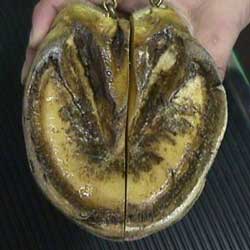A horse’s hoof can be divided into five areas: the wall, the sole, the frog, the periople, and the white line. Hoof growth occurs by cell division of the horn-producing cell layer (stratum germinativum) of the sensitive structures. The hoof wall bears the majority of the horse’s weight and is the most subject to trauma. The hoof wall is visible when the horse is standing.
The wall. The wall is related to the papillae of the sensitive coronary band and the laminae of the sensitive laminae. The horn tubules are primarily responsible for hoof strength, elasticity, and resistance to wear. The inside structure of the wall is composed of horny laminae leaves, which interdigitate with the leaves of the sensitive laminae. This relationship permits the hoof to grow downward and have shock-absorbing capacity.
The toe. The toe is the very front portion of the hoof and hoof wall.
The sole. The thickness and consistency of the sole protects the coffin bone from injury and fracture due to hard objects the horse may encounter when traveling over uneven surfaces.
The frog. The frog’s consistency and shape functions as an anti-concussion and traction device. At varying times during the year (usually twice a year) the frog sheds. When this happens, the horse’s feet are usually tender for a short time.
The white line. The sensitive laminae gives rise to the white line. The white line is actually yellowish in color. It is normally about 1/8 inch wide. The white line separates the wall from the sole and can be seen when looking at the bottom of the hoof.
Quarters. The quarters are located on the sides of the hoof wall. The quarters are the narrowest area of the hoof wall. The hoof wall is widest at the toe and tapers down as it approaches the quarters.
The bars. The bars extend down from the heels and are important in preventing contracted heels. Contracted heels occur when the heels get closer together.
The heels. The heels are formed at the end of the hoof wall and below the bulbs of the hoof.
Bulbs. The bulbs of the heel are elastic, tacky, and greasy to the touch. They are located on the back of the hoof where the wall, heels, and coronary band come together.
Cleft of the frog. The cleft of the frog is the triangle-shaped area in the center of the frog.
Commissure of the frog. The commissure of the frog is the valley between the frog and the bars of the hoof. This area needs to be cleaned regularly to prevent the possibility of thrush developing.




